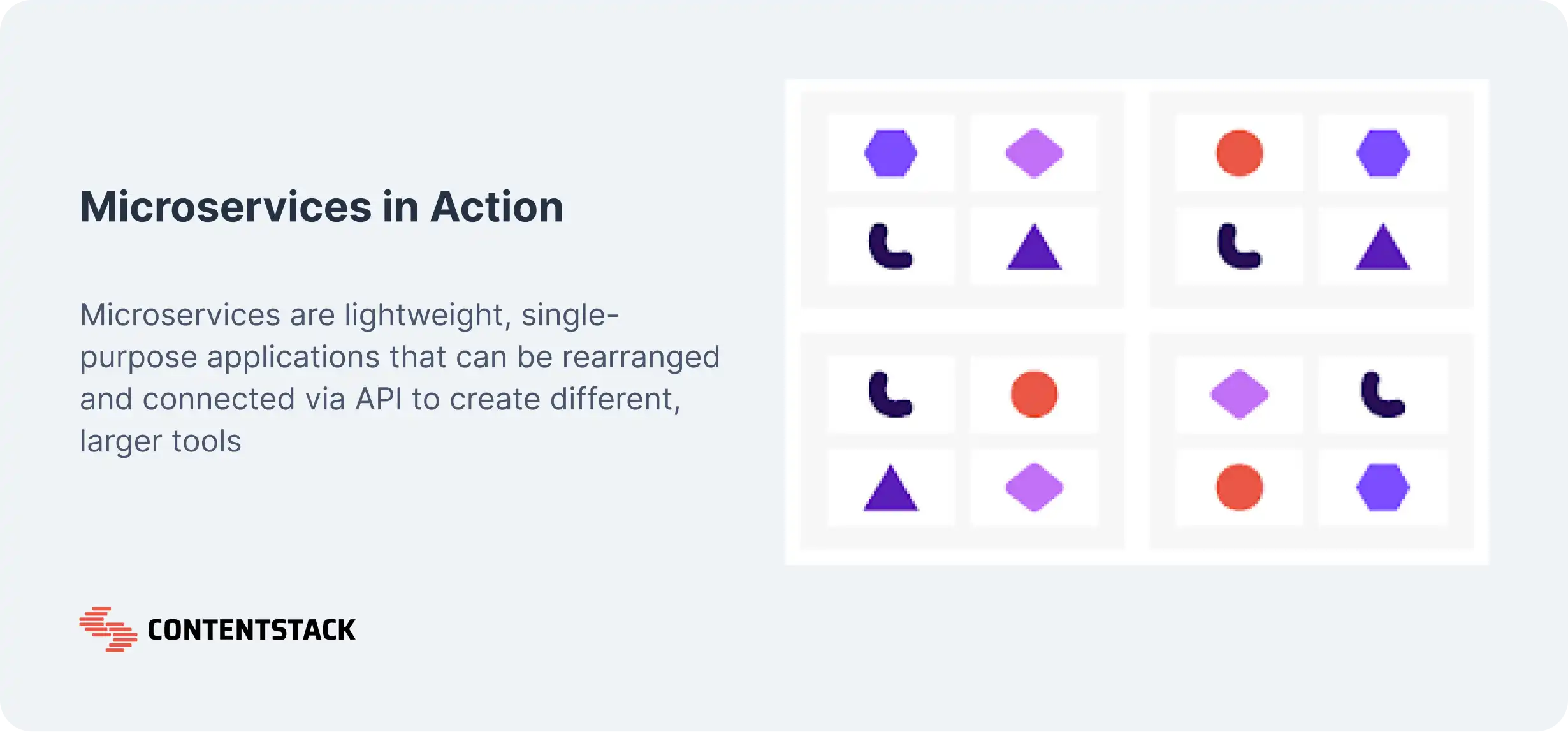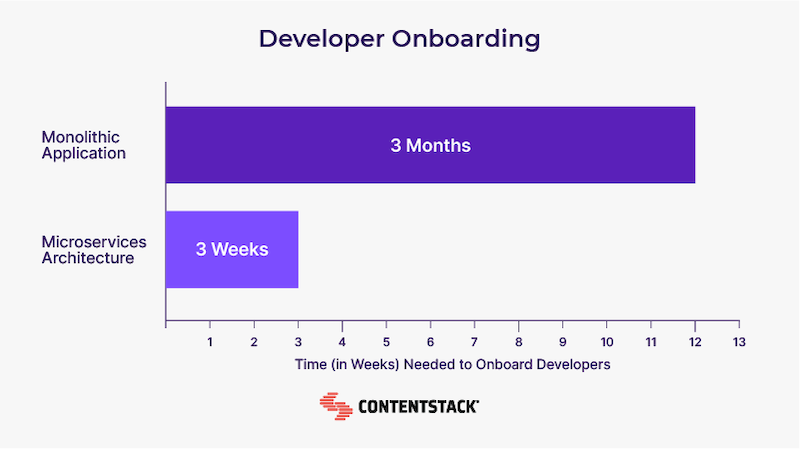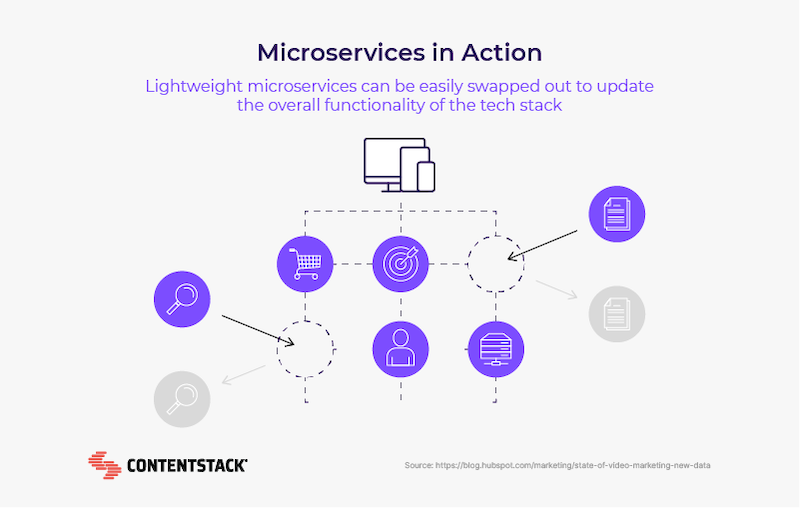Experience agility by transitioning to a microservices strategy
Transitioning to microservices architecture helps you become more agile and flexible. It speeds up digital product development. Plan your migration, and use CI/CD processes and API gateways to see through it. Ready to make the move? Request our free demo to learn more!
Highlights
Making the Move: How to transition to a microservices architecture
- Identify functions in your monolith that you need to migrate and wrap with a feature flag.
- Transitioning from a monolith to microservices is complex but beneficial with proper guidance.
- Evaluate the benefits and challenges of transitioning, especially the learning curve.
- Follow a strategic plan to migrate existing applications to microservices safely.
Ready to revamp your digital strategy? Start your journey with Contentstack's composable DXP. Request a demo to learn more!
Keep reading to learn more!
According to Statista, around 85% of 5,000 large organizations surveyed already use microservices. It shows that businesses believe in the future of microservices. They understand the benefits of transitioning to microservices. Yet, many others still grapple with the challenges of using a monolithic system.
A microservice breaks down an application into smaller, independent, loosely coupled services. It enables teams to collaborate better, push updates and fix services without affecting the main application. This guide provides a strategy for your monolith to microservices migration.

Understanding the monolithic architecture
A monolithic architecture is a unified and traditional way of building applications. It has one code base that connects all the services, although they have different functions.
Although it helps to keep things simple, monolithic architecture may be unreliable and lacks flexibility. They are also quite costly. Software development is slower, and it is more difficult to update the system because you need to update the entire stack.
Start your free trial with Contentstack today. Transform your brand's digital presence with Contentstack's open MACH architecture and industry-leading technology. Witness a significant reduction in publishing and development time, and elevate your content management. Start your free trial now.
The difference between monolithic and microservices architecture
Development process
A monolithic architecture is easier and simpler to start with because it does not require much planning from the start. However, microservices require planning and design. You must identify independent functions and plan for how they interact through APIs.
Modifications
A change or fault in one part affects other parts of a monolithic system. Also, you cannot deploy one part of the system, as you have to do it as a whole. That is not the case in microservices. Microservices are flexible. You can modify, update or deploy a microservice in the cloud without impacting other services.
Scaling
Since every function lives in one code base, it can be difficult to scale a monolithic system. If there is a single requirement in one part of the system, you need to scale the whole system. Microservices scale in a different way because each service has separate resources.
Project size
Microservice architecture is more suited to building large or complex projects, while monolithic architecture is more suited to a small or simple project.
Innovation
Microservices support innovation because developers can build with different technologies and frameworks. That allows them to innovate and add new features quickly. Developers cannot do that when working with monolithic systems, slowing down their ability to innovate and create new features.
Risk reduction
Both architectures experience faults, bugs and code conflicts but handle them differently. If one microservice fails, others continue to function. But a small error in the code can cause the whole monolithic application to fail. That means it carries more risks for developers than microservices.
Time to market
Microservices speed up the development process. So, organizations that use it can create and release digital products faster than those that work with monolithic architectures.

Why transition to microservices?
Improved scalability: Each service has its resources and does not depend on other services, making it easy to update the system. You can also deploy new features faster without taking the whole system offline. So, microservices are an excellent option for organizations that expect rapid growth.
Better security: Due to its granular approach, developers can implement security at the service level. Most microservices connect via secure APIs. That improves data access and security by ensuring that only authorized users and servers can access the system.
Better resilience: If one microservice develops a fault, it does not affect the entire application. Developers can also manage cascading failures with features like circuit breakers, leading to a more resilient system.

Business agility: Developers can work on each small part of an application. That means they can test and deploy faster. The architecture also supports DevOps, ensuring that developers and operations teams can collaborate more and automate tasks.
Increased flexibility: A microservice architecture is tech stack agnostic. So, developers can use the technology stack that fits each microservice. You can connect microservices running on any platform or built with any programming language.
Preparing for the transition
Despite offering many benefits, microservices can get very complex. Hence, it requires careful planning. So, before you make the switch from monolithic to microservices, ensure you plan for it. Planning helps you prepare for potential issues like testing challenges, data management, network latency and service coordination. You also want to sort out API and data security.
The next step is to identify the logical components of your existing application. Isolate your business capabilities and break down the monolithic system into microservices based on that. For instance, you can split an e-commerce application into several microservices such as product catalog, payment processing, user management, etc.
Preparing and breaking down the system components will ensure that it is scalable, flexible and easy to maintain.
Experience future-ready DXP with Contentstack. Contentstack, identified by Forrester's composable DXP award, is an industry leader for enterprises wanting to future-proof their digital strategy. Our high scores in vision and innovation speak for themselves. Request a demo to explore our best-in-class features.
Transitioning from monolith to microservices
Here are the steps for migrating from monolith to microservices:
1. Assessment and planning: Understand the current system and pinpoint dependencies and bottlenecks. Also, understand what areas require independence and, finally, outline your goals.
2. Identify logical components: The three components are data objects, action based on data, and the task at hand or use cases. Identify which of these components of your existing application can work as a separate entity. Then, implement them as separate modules. You can do this by analyzing your application's functions to determine which can operate independently.
3. Flatten and refactor components: After identifying and classifying each module, you must organize them as groups within the company. Check for components that duplicate functions and address them, as only one microservice performs a specific function.
4. Identify the dependencies: Determine the components that depend after you have identified and reorganized them. You can do this through a static analysis of the source code. The analysis will search for calls between various libraries and datatypes.
5. Identify component groups: After you map out the dependencies, organize the components into a group that you can develop into macro or microservices. At this point, you do not need to dwell on the difference between macro or microservices. Your goal is to find objects and their functions that you can separate into different parts of the final system.
6. Setup APIs for the remote user interface: How you design the API will largely determine the migration's success. The remote user interface is the only point of communication for the system, its components, and its users. Ensure it is scalable so that you can add new features further down the line. Also, ensure the API can handle all data interactions in ways that do not change the data too much. After implementing the API, you can then provide new functions via APIs rather than through the monolithic application.
7. Migrate applications: Finally, pull the components, data objects, and functions from the monolithic system and into the new microservices. You can simplify the process by first moving the components of the monolithic application into macroservices. That will offer more insight into how you can further separate them in the microservices architecture.
Overcoming challenges of transitioning to microservices
Transitioning to microservices creates some challenges that you must know and prepare for. For instance, there could be issues with managing data. Moving to a distributed system requires that you consider data storage and access and how it synchronizes across services.
You also need to consider how the services communicate with each other to ensure it is always seamless.
Also, since there are many separate services, things can get complex. So, track and coordinate updates and changes to ensure they are consistent and to avoid disruptions or systems failure.
You can tackle potential challenges in transitioning to microservices architecture by paying attention to these issues and planning for how to handle them.
Knowledge management in microservices transition
When transitioning to microservices, ensure you create and maintain proper documentation. It must spell out everything about the architecture, its design principles and how the microservices interact. Also, ensure you set up a proper way for teams to communicate. That way, you can avoid conflicts and always stay on the same page.
Maintaining a strong testing strategy to minimize risk during the transition is also essential. Test the system throughout the process. Test each microservice and its integration to ensure your application is stable and functions well.
Testing and deployment
The CI/CD processes come into play here. Continuous Integration (CI) deals with merging code changes at regular intervals to make them into a central repository. Continuous Deployment (CD) ensures that every change you make undergoes automated testing and deployment.
As you will receive traffic requests from clients, prepare to manage that. An API gateway takes care of that, ensuring you can route requests and aggregate responses between microservices. It acts as a single entry point for all requests, securing data communication.
Case studies
Cartier
Cartier relied on multiple platforms that were owned and managed by partner resellers.
So, they did not have full control of their digital infrastructure. So, updates and new content took time and too many resources. At times, they had to redevelop the websites, leading to poor brand alignment.
In response, they chose Contentstack's headless CMS as part of their composable DXP. That, combined with the MACH technology they adopted, enabled them to enjoy the benefits of microservices.
Hear from Anastasia Goglova, International Digital Lead. "The websites that are such a critical part of our digital portfolio are now more aligned and more performant. As a result, the customer digital experience of Cartier improves, reflecting our commitment to becoming a reference for luxury in all aspects."
Read more about how Cartier achieves operational efficiency with a composable DXP.
Burberry
Burberry's legacy CMS struggled with the speed of innovation and multiple translation requests it received. That meant they could not release products on time, and they could not scale. The brand experience suffered.
For them, the answer was switching from monolithic to microservices, and Contentstack's composable DXP offered that. The new solution increased their speed and agility, and it also offered language management and integration. Translation work became 80% faster and calls to the development team were reduced from around 40 per week to one.
"Contentstack helps our engineers to move fast and concentrate on business requirements by reducing proprietary platform inconveniences," said Sonia Latoracca, digital commerce content manager.
Read more about how Burberry achieves speed and agility through Contentstack's composable DXP.
FAQ section
What is a microservice architecture?
It is an architectural style that splits up an application into small, separate microservices. These small components use their resources, run unique processes, and interact via lightweight tools, such as RESTful APIs.
Why is transitioning to microservices beneficial for my business?
Transitioning to a microservices strategy enables you to become an agile enterprise. It enables you to build digital products faster. You also become more flexible, as you can use different technology stacks for each microservice.
What are the steps involved in transitioning from monolith to microservices?
It starts with planning to define your purpose. After that, you must identify logical components and flatten and refactor them. Next, you identify dependencies and component groups and develop secure APIs before slowly pulling all the monolithic components into microservices.
How can I overcome the challenges faced during the transition to microservices?
You can overcome the challenges by planning the migration. Also, test and deploy via CI/CD processes and use an API gateway to manage requests and communication. Maintain proper documentation of the system, its design and processes, and test it often to ensure it works well.
How does an API gateway play a role in deploying microservices independently?
API gateways manage all client requests and direct them to the right microservice. It secures data communication between services. An API gateway also does other things, such as service discovery and load balancing. It also offers extra security by authorizing users.
Learn more
Moving from monolithic to microservices comes with its challenges. But done right, it will transform your business, helping you become agile and resilient. It speeds up application development, ensuring you can deliver innovative digital experiences.
Although challenging, you can get it right by planning and following the systematic approaches in this blog. Are you ready to make that move? Request our free demo to learn more about microservices and how they can benefit your business.
